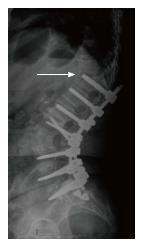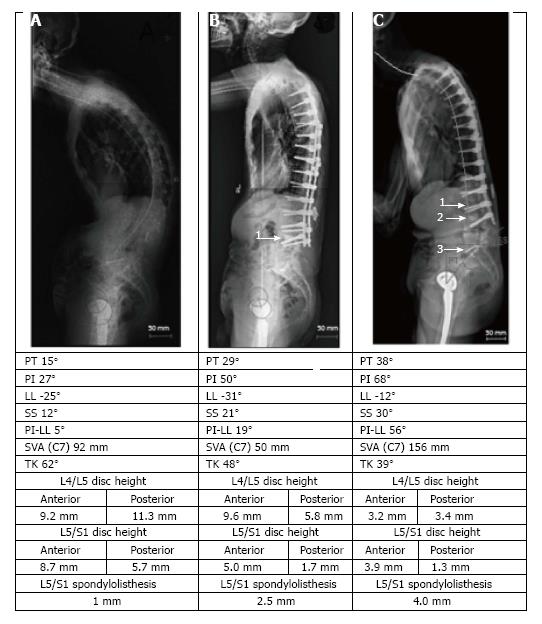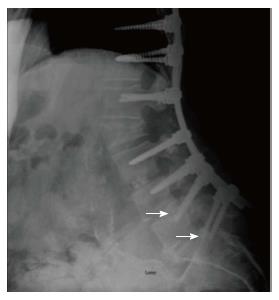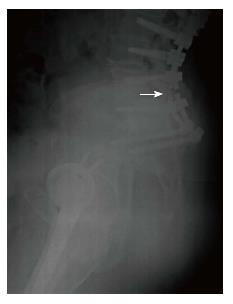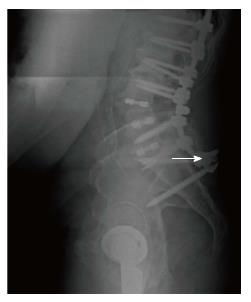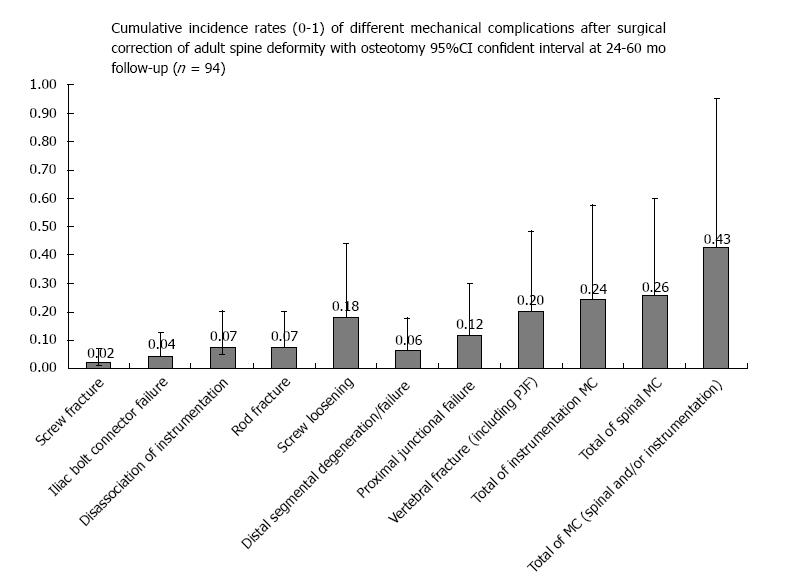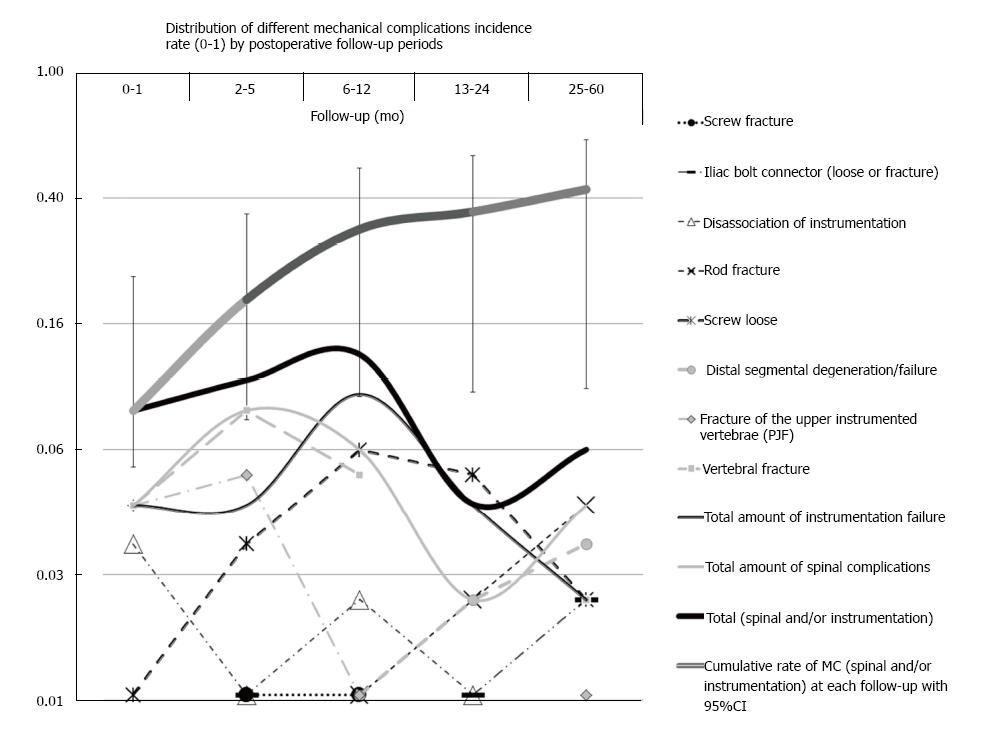Copyright
©The Author(s) 2017.
World J Meta-Anal. Dec 26, 2017; 5(6): 132-149
Published online Dec 26, 2017. doi: 10.13105/wjma.v5.i6.132
Published online Dec 26, 2017. doi: 10.13105/wjma.v5.i6.132
Figure 1 Example of radiographic findings of proximal junctional failure.
Compression fracture of T11 proximal junctional failure (PJF) with screw pullout is shown by a white arrow. It was diagnosed at 1 mo follow-up after the surgical adult spine deformity correction using lumbar osteotomy and long thoracolumbar fusion surgery with fixation to sacrum. Before diagnosis of PJF, the patient experienced increased back pain limiting walking distance and increasing sagittal imbalance. The patient was revised with removal of the pedicle screws at T11 with extension of instrumentation to T9 two months after the index surgery.
Figure 2 Example of distal segment degeneration/ failure.
This event was observed after surgical correction of adult spine deformity in a patient (67 years old male) with idiopathic kyphoscoliosis complicated by degenerative disc disease and lumbar stenosis. A: Severe preoperative spinal kyphosis; B: Postoperative correction by T3-L4 posterior instrumented fusion with L3/L4 decompression, transforaminal interbody fusion by cage placement (1), and multilevel (T5-T11) Smith-Petersen osteotomy; C: Distal segment degeneration/ failure at 35 mo follow-up with deformation and/or fracture of L3 (1) subsidence of the interbody cage (2), collapse of L4/L5 and L5/S1 intervertebral discs with L5/S1 spondylolisthesis (3), loss of sagittal balance, and progression of proximal junctional kyphosis. Interestingly, these changes were accompanied by significant increase of pelvic incidence (PI) from 27° to 68° due to simultaneous increase of pelvic tilt (PT) and sacral slope which suggested that position of sacrum relatively to pelvis changed after surgery. Likely, this is the result of displacement in the sacroiliac joints. This finding contravenes the concept concerning postoperative stability of PI.
Figure 3 An example of radiographic findings of screw pullout/loosening.
Screw pullout is shown by white arrows at L5 and S1 bilaterally identified at the 6 mo follow-up visit after surgical correction of adult spine deformity with osteotomy. Pseudarthrosis was diagnosed later at 12 mo post-operative. The patient experienced increasing low back pain and “popping” with movement. A revision operation was performed at 12 mo follow-up to revise the fusion and re-instrument, including placement of iliac bolts.
Figure 4 An example of radiographic findings of rod fracture.
Bilateral L5-S1 rod fractures are shown by white arrow; they were diagnosed consequently at 12 and 20 mo follow-up after surgical correction of adult spine deformity, and accompanied with L5-S1 pseudo-arthrosis. The pseudo-arthrosis at L5-S1 was diagnosed simultaneously with the second rod fracture at 20 mo follow-up. The patient experienced increasing low back pain and sagittal imbalance. A revision operation was performed at 21 mo follow-up with revision of the fusion and an osteotomy to correct residual sagittal imbalance.
Figure 5 An example of radiographic findings of disassociation of instrumentation.
Uncoupling of the rod from the iliac bolts disassociation of instrumentation is shown by white arrow; it was diagnosed at 4 mo follow-up after surgical correction of adult spine deformity. The patient experienced ongoing low back pain. A revision operation was performed with replacement of iliac screws and connectors. Intraoperatively, it was noted that the right pelvic screw cap had disengaged.
Figure 6 Cumulative incidence rates of different mechanical complications after surgical correction of adult spine deformity with osteotomy at long term postoperative follow-up; the error bars show 95%CI.
PJF: Proximal junctional failure; MC: Mechanical complications.
Figure 7 Distribution of different types of mechanical complications after surgical correction of adult spine deformity with osteotomy by different periods of long-term postoperative follow-up; the error bars show 95%CI.
MC: Mechanical complications.
Figure 8 Failure of the bone-screw interface.
This effect was observed in a 75-year-old male after surgical correction of adult spine deformity with T12-L2 instrumented fusion, L1/L2 Smith-Petersen osteotomy, and transforaminal interbody fusion. A: Postoperative pedicle screws placed at T12 with good contact between the screws and the bone (absence of noticeable radiolucency around the screws); B: Loosening of the screws with loss of boney fixation that was revealed at 6 mo follow-up. This effect is viewed as radiolucency around the screw (1). This may be due to bone resorption, starting the process of screw pullout at 6-mo follow-up.
- Citation: Barton C, Noshchenko A, Patel VV, Cain CMJ, Kleck C, Burger EL. Different types of mechanical complications after surgical correction of adult spine deformity with osteotomy. World J Meta-Anal 2017; 5(6): 132-149
- URL: https://www.wjgnet.com/2308-3840/full/v5/i6/132.htm
- DOI: https://dx.doi.org/10.13105/wjma.v5.i6.132













